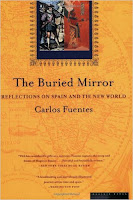Carlos Fuentes, as quoted by Robert Royal in
- 2014 January 11 (no citation)
- 2006: The God that did not fail (New York: Encounter Books, 2006), 158 and 288n13, citing "The buried mirror: reflections on Spain and the New World ([Boston and] New York: Mariner, [Houghton Mifflin Company,] 1999)" (no page number). There I have have found only this so far, on p. 146 (pp. 156-157 in the Spanish edition of 1992). It's comparable, but note that it comes up (in this book) readily in a Google search, while the Royal wording (above) returns only publications by Royal:
In actual fact, it comes from near the end of the second episode of the documentary The buried mirror: reflections on Spain and the New World (the episode entitled The conflict of the gods), where it follows some comments on the adoption of the Blessed Virgin as mother (cf. "The conquered people now had a mother. They also found a father" (p. 146)), and is worded somewhat differently:In a universe accustomed to seeing men sacrificed to the gods, nothing amazed the Indians more than the sight of a god who had sacrificed himself to men. It was the redemption of humankind by Christ that fascinated and really defeated the Indians of the New World. The true return of the gods was the arrival of Christ. Christ was the recovered memory that in the beginning it was the gods who sacrificed themselves for the benefit of humankind. This misty memory, engulfed by the somber human sacrifices ordained by Aztec power, was now rescued by the Christian church. The result was flagrant syncretism, the blending of Christian and aboriginal faiths, one of the cultural foundations of the Spanish American world.
This new world wanted a father. It did not find him in the figure of the conquistador, but in that of Christ. One can only imagine the astonishment of the hundreds and thousands of Indians who asked for baptism as they came to realize that they were now to adore a god who sacrificed himself for men instead of asking men to sacrifice themselves to the gods, as the Aztec religion had demanded. It is surely no accident that on this statue it is the heart, the ultimate gift of sacrifice, that is so prominently displayed.In the book this is anticipated by the opening pages of chapter five ("The rise and fall of the Indian world"): "Because the gods had sacrificed themselves so that the world and humanity might exist, humanity was obligated to plunge, if needed, into the great, permanent bonfire of life and death", such that "The need for sacrifice was an undoubted thing in Indian society, not subject to discussion or skepticism of any sort" (p. 94). Whether it is anticipated in quite this way in the documentary, I have not yet determined.


No comments:
Post a Comment